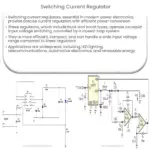Explore the workings of an SCR Voltage Regulator, its applications, advantages, and disadvantages. Delve into the world of efficient power management.
![]()
Introduction to SCR (Silicon Controlled Rectifier) Voltage Regulator
Electricity is an integral part of our lives, powering everything from our homes to our industries. However, managing electrical power involves several challenges, one of which is maintaining a constant voltage level. To manage voltage levels and ensure stability, we use devices known as voltage regulators. Among various types of voltage regulators, the SCR (Silicon Controlled Rectifier) Voltage Regulator holds a significant place due to its efficiency and versatility.
Understanding Silicon Controlled Rectifiers
Before delving into the specifics of SCR Voltage Regulators, it’s essential to understand what a Silicon Controlled Rectifier is. A Silicon Controlled Rectifier or SCR is a type of semiconductor device that belongs to the family of thyristors. Primarily used for the control and rectification of electrical power, SCR is a three-terminal device with Anode, Cathode, and Gate terminals.
- Anode (A): This terminal is connected to the positive side of the power supply.
- Cathode (K): This terminal is connected to the negative side of the power supply.
- Gate (G): This terminal controls the triggering of the SCR.
The Principle of Operation of an SCR
The operation of an SCR is based on the principle of “controlled conduction”. In its default state, an SCR is ‘off’ or in a blocking state, with no current flowing between the anode and cathode. When a small current is applied to the gate terminal, the SCR ‘turns on’, allowing a larger current to flow from the anode to the cathode. This state is called the ‘forward conduction’ state. The SCR will remain in this state, regardless of the gate current, until the current through the device drops below a certain threshold known as the ‘holding current’. Once the current falls below the holding current, the SCR switches back to its ‘off’ or blocking state.
SCR as a Voltage Regulator
SCRs are widely used in power electronics for their ability to handle high voltages and currents. SCR Voltage Regulators make the most of this capacity by controlling the amount of power delivered to a load by adjusting the firing angle or the phase angle at which the SCR is triggered on. The ability to control this firing angle allows for precise control of the output voltage, making SCR Voltage Regulators extremely effective in power management scenarios.
Applications of SCR Voltage Regulators
SCR Voltage Regulators are commonly used in various industrial and domestic applications due to their high reliability, durability, and excellent performance in regulating voltage. Here are a few of their prominent applications:
- Power Supplies: SCR Voltage Regulators are extensively used in regulated power supplies to ensure a constant output voltage, regardless of variations in the input voltage or load current.
- Motor Control: In motor speed control applications, SCR Voltage Regulators are used to regulate the power supplied to the motor, thereby controlling the speed of the motor.
- Heating Control: In electric heating systems, SCR Voltage Regulators are used to control the power delivered to the heating elements, thereby controlling the temperature.
- Light Dimming: SCR Voltage Regulators are used in light dimming circuits to control the intensity of light produced by incandescent lamps.
Advantages and Disadvantages of SCR Voltage Regulators
Like any other device, SCR Voltage Regulators come with their own set of advantages and disadvantages. Let’s take a look at some of them:
- Advantages:
- High efficiency and excellent voltage regulation.
- Capability to handle high voltages and currents.
- Relatively simple and inexpensive to design and implement.
- Disadvantages:
- SCRs can only conduct in one direction, limiting their use in AC circuits.
- The operation can be affected by temperature variations.
- They can generate electrical noise due to abrupt switching.
Conclusion
In conclusion, the SCR (Silicon Controlled Rectifier) Voltage Regulator is a valuable device in power electronics, offering efficient and reliable voltage regulation. Its ability to handle high voltages and currents, coupled with its simplicity and cost-effectiveness, make it a popular choice in numerous applications. However, like any other device, it’s not without its challenges, and careful consideration should be given to its limitations when designing circuits. Nevertheless, as technology continues to advance, we can expect to see even more innovative uses and improvements in SCR Voltage Regulators.



